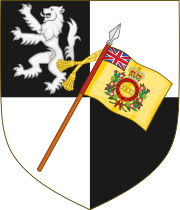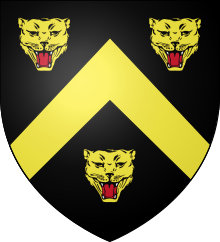Earl of Strafford
| Earldom of Strafford (Third creation) | |
|---|---|
  Arms of Byng, Earls of Strafford: Quarterly sable and argent in the first quarter a lion rampant of the second over all in bend sinister a representation of the colours of the 31st Regiment of Foot. Crests, 1st: Out of a mural crown an arm embowed grasping the colours of the 31st Regiment of Foot and pendent from the wrist by a ribbon the Gold Cross (awarded to the 1st Earl for gallantry), all proper, and on an escroll the word MOUGUERRE, 2nd: An heraldic antelope statant ermine attired or. Supporters: dexter: An heraldic antelope ermine attired or, sinister: A lion or. | |
| Creation date | 18 September 1847 |
| Creation | Third |
| Monarch | Queen Victoria |
| Peerage | Peerage of the United Kingdom |
| First holder | John Byng, 1st Baron Strafford |
| Present holder | William Byng, 9th Earl of Strafford |
| Heir apparent | Samuel Byng, Viscount Enfield |
| Remainder to | Heirs male of the first earl's body lawfully begotten |
| Subsidiary titles | Viscount Enfield Baron Strafford |
| Seat(s) | Wrotham Park |
| Motto | Tuebor (I will defend)[1] |


Earl of Strafford is a title that has been created three times in English and British history.
The first creation was in the Peerage of England in 1640 for Thomas Wentworth, the close advisor of King Charles I. He had already succeeded his father as second Baronet of Wentworth Woodhouse in 1614. The Wentworth Baronetcy, of Wentworth Woodhouse in the County of York, had been created in the Baronetage of England on 20 June 1611 for Thomas's father, William Wentworth.[2] Thomas was created Baron Wentworth, of Wentworth-Woodhouse, Baron of Newmarch and Oversley, in 1628, and Viscount Wentworth in 1629. He was made Baron Raby in 1640, at the same time he was given the earldom.[3]
In 1641, he was attainted. His son, William, successfully had the attainder reversed in 1662, becoming the second earl, but died without heirs in 1695 when the barony of Wentworth, viscountcy and earldom became extinct. He was succeeded in the barony of Raby according to a special remainder by his first cousin once removed, Thomas Wentworth, who became the third Baron. He was the grandson of Sir William Wentworth, younger brother of the first Earl of the 1640 creation. While gaining the barony, he did not receive the Woodhouse estate, which was inherited by Thomas Watson, thereafter a source of rivalry between the two men.[1]
In 1711, the earldom was recreated when the 3rd Baron Raby was created Viscount Wentworth and Earl of Strafford in the Peerage of Great Britain. He was created Duke of Strafford in the Jacobite Peerage on 5 January 1722. He was succeeded in 1739 by his son, William, the second earl. William had no issue and on his death in 1791 the Jacobite peerages, such as they were, became extinct. He was succeeded in the remaining peerages by his cousin Frederick. As he also had no successors, all titles became extinct on his death in 1799.[1][3]
The title was created for a third time in 1847 in the Peerage of the United Kingdom, when the prominent soldier John Byng, 1st Baron Strafford, was made Viscount Enfield, of Enfield in the County of Middlesex, and Earl of Strafford.[4] He had already been created Baron Strafford, of Harmondsworth in the County of Middlesex, in 1833.[5] John Byng was the second son of George Byng (c.1735-1789), son the Hon. Robert Byng (1703-1740), third son of George Byng, 1st Viscount Torrington (1663-1733). John Byng's mother was Anne Conolly, whose mother was Lady Anne Wentworth, a daughter of Thomas Wentworth, 1st Earl of Strafford (1672-1739) (of the second creation). John Byng was thus a great-grandson of the 1st Earl of Strafford. John Byng was succeeded by his eldest son, the second Earl. He was a Whig politician and held minor office under Lord Grey, Lord Melbourne and Lord John Russell.[1]
His eldest son, the third Earl, was a Liberal politician and served under William Ewart Gladstone as Parliamentary Under-Secretary of State for Foreign Affairs and Under-Secretary of State for India. In 1874, twelve years before he succeeded his father, he was summoned to the House of Lords through a writ of acceleration in his father's junior title of Baron Strafford. On his death the titles passed to his younger brother, the fourth Earl. He was succeeded by his younger brother, the fifth Earl. He was a clergyman. His son, the sixth Earl, was a County Alderman in Middlesex and Hertfordshire. He was succeeded by his nephew, the seventh Earl. He was the second but only surviving son of the Hon. Ivo Francis Byng, fourth son of the fifth Earl. As of 2016 the titles are held by his grandson, the ninth Earl.
Another member of the Byng family was the soldier Field Marshal Julian Byng, 1st Viscount Byng of Vimy. He was the youngest son of the second Earl of Strafford from his second marriage.
Family homes are divided up among its branches but Wrotham Park, historically in Middlesex but now Hertfordshire, and a 17th-century one-storey plus attic cottage in Vernhams Dean, Hampshire have become arguably established seats.[6] Wrotham Park was named as the 17th patriarchs in the family originally had an estate in Wrotham, Kent which they sold.[7]
The traditional burial place of the Byng Earls of Strafford is the Byng Mausoleum at Wrotham Park,[8] not to be confused with the Byng Mausoleum in Southill Church, Bedfordshire, built for the burial of the 1st Viscount Torrington, seated at Southill Park.
Wentworth Baronets, of Wentworth Woodhouse (1611)[]
- Sir William Wentworth, 1st Baronet (d. 1614)
- Sir Thomas Wentworth, 2nd Baronet (1593–1641) (created Earl of Strafford in 1640)
Earls of Strafford, First Creation (1640)[]
- Thomas Wentworth, 1st Earl of Strafford (1593–1641) (forfeit 1641)
- William Wentworth, 2nd Earl of Strafford (1626–1695) (attainder reversed 1662)
Barons Raby (1640; Reverted)[]
- Thomas Wentworth, 3rd Baron Raby (1672–1739) (created Earl of Strafford in 1711)
Earls of Strafford, Second Creation (1711)[]
- Thomas Wentworth, 1st Earl of Strafford (1672–1739)
- William Wentworth, 2nd Earl of Strafford (1722–1791)
- Frederick Thomas Wentworth, 3rd Earl of Strafford (1732–1799)
Barons Strafford, of Harmondsworth (1835)[]
- John Byng (created Earl of Strafford in 1847)
Earls of Strafford, Third Creation (1847)[]
- John Byng, 1st Earl of Strafford (1772–1860)
- George Stevens Byng, 2nd Earl of Strafford (1806–1886), son.
- George Henry Charles Byng, 3rd Earl of Strafford (1830–1898), son.
- Henry William John Byng, 4th Earl of Strafford (1831–1899), brother.
- Francis Edmund Cecil Byng, 5th Earl of Strafford (1835–1918), brother.
- Edmund Henry Byng, 6th Earl of Strafford (1861–1951), son.
- (1904–1984), nephew.
- (1936–2016)
- William Robert Byng, 9th Earl of Strafford (b. 1964)
The heir apparent is the present holder's son Samuel Peter Byng, Viscount Enfield (b. 1 July 1998), elder twin brother of Isaac John.[1]
See also[]

- Viscount Torrington
- Viscount Byng of Vimy
References[]
- ^ Jump up to: a b c d e Mosley, Charles, ed. (2003). Burke's Peerage, Baronetage & Knighthood (107 ed.). Burke's Peerage & Gentry. pp. 3766–3768. ISBN 0-9711966-2-1.
- ^ George Edward Cokayne Complete Baronetage 1900
- ^ Jump up to: a b Burke, John (1838). A genealogical and heraldic history of the extinct and dormant baronetcies of England, by J. and J.B. Burke. p. 558. Retrieved 24 December 2016.
- ^ "No. 20769". The London Gazette. 31 August 1847. p. 3162.
- ^ "No. 19268". The London Gazette. 8 May 1835. p. 900.
- ^ Historic England. "Apple Tree Cottage (1302877)". National Heritage List for England. Retrieved 27 October 2014. One of the Grade II listed cottages in Vernhams Dean
- ^ History Archived 2014-10-29 at the Wayback Machine Wrotham Park
- ^ Byng Mausoleum
External links[]
- Hansard 1803–2005: contributions in Parliament by Thomas Edmund Byng, 8th Earl of Strafford
- Extinct earldoms in the Peerage of England
- Extinct earldoms in the Peerage of Great Britain
- Earldoms in the Peerage of the United Kingdom
- Byng family
- Noble titles created in 1640
- Noble titles created in 1711
- Noble titles created in 1847
- Noble titles created for UK MPs
- Earls of Strafford (1640)

